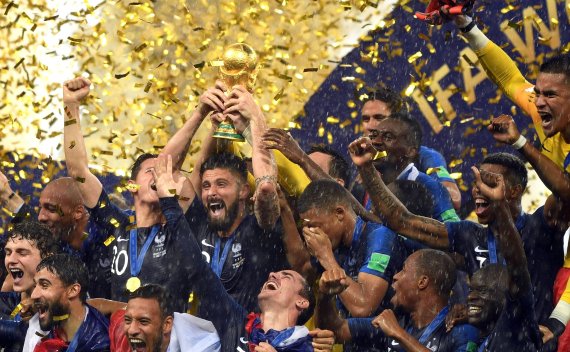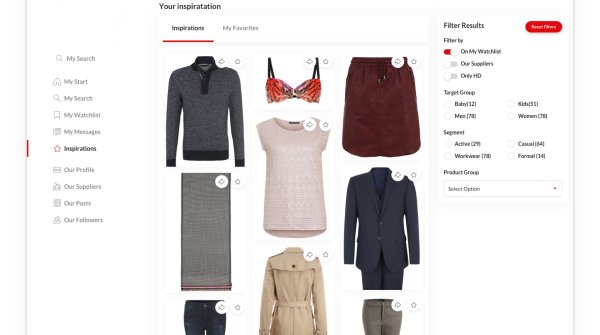
The Fifa World Cup is a massive attention grabbing and money-making endeavor. According to "France 24" Fifa netted 6 billion dollars in revenue from the 2018 World Cup. Like most sports organizations, Fifa does not produce its own merchandise. Rather, it licenses its brand for a fee to various companies. If one were to visit an official Fifa store in Moscow, or visited the official online Fifa store, you would find licensed gear – jerseys, t-shirts, shorts, socks, balls, etc. – produced by Nike, Puma, Adidas, and New Balance, among others.
Items produced for the World Cup have a problem other sports apparel items typically don’t. As teams win and lose, the popularity of their apparel should rise and fall quickly and accordingly. If a company had looked at 2014’s results and stockpiled large numbers of the winner’s jersey, they would now mostly like have a huge surplus after Germany was knocked out of the tournament early on. Likewise, while demand for both the gear of France and Croatia surely rose leading up to the final match, there is almost certainly greater interest in France’s merchandise since securing the title.
In order to react to the ebb and flow of any future tournament, companies need to ensure their supply chains are as streamlined as possible, and that they’re able to estimate demand as accurately as possible. One approach would be to adapt sourcing processes from a planning-oriented model to a behavior driven one. This requires companies to be more in tune with customers’ current interests instead of engaging in the more traditional practice of planning a year’s trends and styles in advance.
Manufacturers, too, would want to try and attach themselves to one of the brands that sponsor a team competing in the World Cup, as even initial demand for home team apparel sees an increase in sales.
So how much, exactly, are these companies producing? A lot. For the 2014 World Cup alone over “150 million official licensed products” were sold at the 1,000 plus official tournament and fan stores. Even in a non-World Cup year, sales of jerseys for a single club can be in the millions, as illustrated by the 2.8 million Manchester United jerseys sold in 2016. This year, Nigeria’s wildly popular home jersey logged 3 million pre-orders and sold out in the blink of an eye on its June 1st debut.
In order to get an idea of how Fifa gear is currently selling we will take Adidas and Nike as a sort of benchmark, since the two companies together sponsor 22 of the 32 teams competing in the 2018 World Cup. According to a report by Thomson Reuters, both companies have managed to sell Fifa apparel with minimal markdowns while moving goods at a healthy pace.
This is quite impressive, as normally apparel companies struggle to sell all of their standard inventory without significant price reductions. In 2014, Adidas sold 8 million jerseys, with 3 million of those being from the German team according to ISPO, while selling over 80% of its stocks before the 2014 World Cup even began. Something similar happened this year, with Nike reportedly selling 28% of all of its World Cup merchandise available in the U.S. over the span of a single week.
Where does all the Fifa apparel come from? As it turns out much the same place as everything else. By analyzing available data for apparel produced under the Nike brand, it turns out there are a possible 302 factories in 37 countries that can be producing Fifa apparel. This, however, only accounts for factories producing finished goods, and not ones responsible for manufacturing materials.
It is perhaps unsurprising that these factories are predominantly based in Asia, where labor is cheap and there is an experienced garment and textile industry, though there is a sizeable number of factories located in the United States. The same is true for Adidas, except that in this case there are nearly 800 factories operating in more than 50 countries around the world producing apparel and “gear.”
As a way to tackle demand issues Nike outlined in its new digital strategy a plan for increased customer engagement on its digital outlets. Not only do digital platforms allow any company to get direct, regular customer feedback, but they enable companies to review purchasing trends and tastes of their customers by analyzing data, a practice any company looking to maintain its competitiveness would be smart to embrace.
By way of example a company could, theoretically, look at the sales data gathered from its online store and see that regardless of team t-shirts in general seem to be in high demand. They can then put in orders of larger numbers of team branded t-shirts to try and meet demand before the tournament is over.
In the case of the World Cup maintaining an adequate supply chain and having up-to-date data are especially important. Lead times of several weeks are impossible to avoid for most apparel items, which represents a problem for an event that takes place over the course of only four weeks. Being understocked is a huge missed opportunity when fans are buying apparel by the tens of millions.
And while it may be impossible for apparel companies to accurately predict the outcome of every match months in advance, maintaining a flexible and reactive supply chain enables companies to capitalize on intense demand before it fades.
 OutDoor by ISPOHow you benefit from communities as a brand
OutDoor by ISPOHow you benefit from communities as a brand




